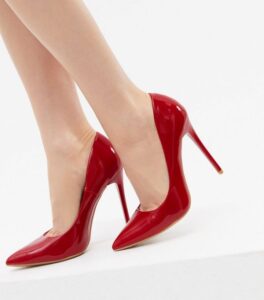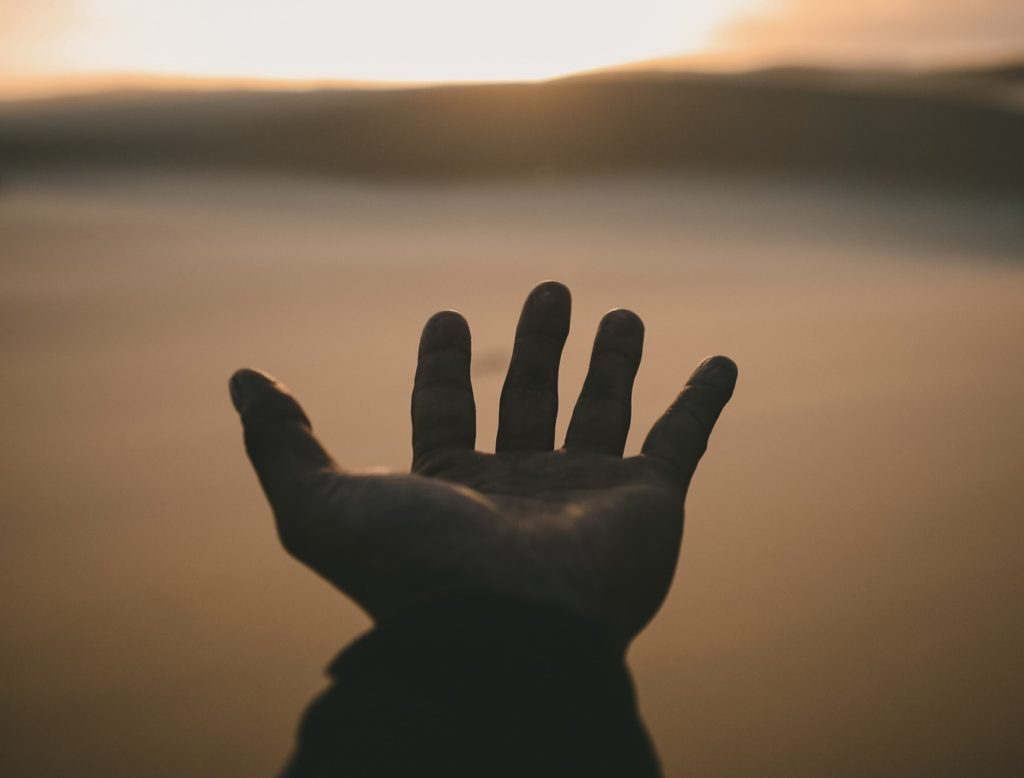| Imagine you’re at a trailhead in the wilderness. Sunrise is lightening the eastern sky, birds are singing their dawn song in the tops of the firs, and the creek beside your trail is burbling happily, full of fresh snowmelt, beckoning you upward. You’re excited to climb to the top of the mountain on the horizon, with the last of the night’s stars fading away behind it. You’ve wanted to climb this mountain for years, and today is the day. You take one last drink of water, shoulder your pack, strap on your hiking poles, and embrace the journey ahead. But then. A voice. It belongs to a young man emerging from the trees. He wears an official uniform and a badge, and he tells you to stop. “Hold up,” he says. “I’m going to give you some of these before you go.” He gestures to a table laden with a strange assortment of objects: rocks in ten-pound bags, pairs of shiny red stilettos, rolls of Cling Wrap, and heavy mittens. He tells you to remove your sturdy trail shoes and replace them with the stilettos, puts two bags of rocks in your backpack, and wraps your head in Cling Wrap in which he’s poked tiny holes for your nose and your mouth. You object, although it’s difficult through the plastic wrapped around your head. He says, “Sorry, ma’am. This is how it is. I don’t make the rules. Oh. I almost forgot. You have to give me half your food.” This seems strange to you. You wonder who’s making these rules, but you give the young man most of your lunch and start up the trail. You’re beginning to wonder if you’ll make it up that mountain. Thoughts create feelings which lead to actions that accumulate as results. Period. That’s what I learned in Wayfinder coach training, and it’s what I’ve taught clients myself. The idea is that once we can catch a thought causing suffering, we can do the work to change the thought. Because, thankfully, thoughts, unlike feelings, are changeable. (Changing an action without changing the thought(s) motivating the action is white-knuckling ourselves into a desired state. This “change through brute force” takes lots of will power, a finite resource.) This black and white, clear cut, linear formulation is the foundation of Cognitive Behavior Therapy (CBT), and it’s been helpful for many. Well. Turns out it’s not true, that feelings are always, 100%, no exceptions, caused by thoughts. Researchers are finding that what eases suffering isn’t changing the thought, but getting distance from it. Learning to detach from a thought causing suffering is one of the pillars of Acceptance and Commitment Therapy (ACT). I now have a broader understanding and therefore a more nuanced perspective on thoughts, feelings, and actions. Thoughtwork is great for thoughts causing suffering. We suffer when we take life’s inevitable pain personally. Thoughtwork used on pain, not suffering, is ineffective and potentially harmful. That said, “unhelpful thoughts create unhelpful feelings that lead to unhelpful actions” is true often enough that it’s worth having some basic thoughtwork tools in your toolbox to ease your suffering. I’ve been playing around with a new one, and want to share it with you. It’s called “Cruel, Sadistic Operating Instructions.” Cruel, Sadistic Operating Instructions I found this one in Carolyn Elliott’s book Existential Kink. (The book has a lot of wacky stuff IMO, but this tool is priceless.) She calls it “How to Beat Yourself Up (the Fun Way).” In Carolyn’s words: “Make your cruel, sadistic ‘operating instructions’ radically explicit.” Here’s how it goes. Dig deep and see if you can uncover the real rules you live by—your cruel, sadistic operating instructions. We find our cruel, sadistic operating instructions when we investigate where we’re suffering. You know what suffering feels like. It feels weighty, stuck, trapped, caged, stagnant, frustrating. Anger that never goes away. Despair that persists. Attempts to control the uncontrollable. Pain, by contrast, moves through us. Pain ebbs and flows. Pain is alive. Look where you feel deadness, and you will find your suffering. Here are some of my cruel, sadistic operating instructions: I must never, ever, ever expand and grow bigger than my childhood roles and identity. I must never, ever, ever, create something original—art, writing, a coaching process, a business—because it might be flawed or ugly and therefore unworthy of existence. The only thoughts that matter are the ones others think or have thought. I must always listen and never speak. I must never, ever, ever decide anything for myself. I must never, ever, ever feel exuberant happiness. I must never, ever, ever do anything I might not get perfect the first time. No mistakes, ever. And so on. Now, of course these aren’t true. They’re ridiculous—statements I would never, ever, ever say to my kids or to anyone else. I have managed to expand, create, think for myself, speak up, feel happy, and make decisions. But doing those things has been harder than they needed to be, because of my buried operating instructions. Articulating my actual cruel, sadistic operating instructions helps me see how they’re still controlling me. I’ve been white-knuckling myself past my operating instructions, feeling anxious and guilty when I break them. They’re buried deep. Like vampires, exposing these rules to the light takes away their power. Uninstalling the operating instructions that no longer serve me is a skill. And that’s where thoughtwork comes in. So, what’s going on with you, dear mountain climber? Well, you’re doing your best to get up that trail with all those impediments. After all, you think, this is how he said it needed to be. I don’t understand, but I don’t have a choice. This must be how everyone does it. Maybe there’s something wrong with me, that this is so hard. You walk and you walk and you walk, grinding out step after step in those god-awful shoes, sweat pooling under the Cling Wrap, trying to see through the layers of plastic film, carrying that heavy, heavy backpack. Until you just can’t anymore. You teeter your way to the creek bank, heels catching on rocks, ankles twisting, and slide down onto the grass. You shrug off your backpack, kick off those ridiculous shoes, rip the Cling Wrap from your head, and put your feet in the water. Cold water flows over your blistered feet, fir-scented breezes cool your sweaty head, your shoulders relax and soften. A Dipper flies downstream. You’re tapped out. You’ve hit a wall. You know you can’t go any further, and you so badly wanted to get to the mountain top. You sit, trying to accept your disappointment. Then you notice that the Dipper is in the creek in front of you, watching you. She’s been there for some time, perched on top of a log in the water on the other side of the creek, singing and dipping as Dippers do. The log is hollow, and inside the log is a box. You wade toward the log. The Dipper watches your steady progress, bopping up and down encouragingly. You reach the log and pull out the box. Behind the box, deep in the hollow log, is a pair of sturdy trail shoes, your size, in the color you always wanted but REI was always sold out of. Oh, hell no, you think. I am not wearing those ridiculous stilettos one more goddamn minute. You carry the shoes and the box back across the creek. Sitting there with your feet in the water, the fir-scented breeze playing with your hair, the sound of the creek in your ears, you open the box. Inside is the food you left with the young man at the trailhead—your turkey sandwich, your bag of Fritos, and your oatmeal cookie. You’re beginning to believe you can get to the top of the mountain after all. Why would I keep carrying this stuff?, you think. You pull the bags of rocks out of your backpack and empty them into the creek. You stuff the empty bags, the wad of sweaty Cling Wrap, and your lunch into the backpack, dry your feet, and put on your beautiful new shoes. They feel so good. You return to the trail and resume your journey toward the mountain that is your goal: snow-capped, sturdy, shining in the morning sun. You’re strong. You’re brave. And you’re really looking forward to getting to the top of that mountain. Those stilettos? They’re swinging jauntily off your backpack by their sparkly straps. You’re not sure yet what you’ll do with them, but you know it’ll be something good. PS. If you’d like to share your Cruel, Sadistic Operating Instructions, hit reply. Confidentiality guaranteed. You can also tell me what you’ll do with those damn stilettos. I’d love to know! PPS. If you’d like to explore your operating instructions together, I offer a no-cost, no-obligation Clarity Call. PPPS. Thoughtwork is an integral component of Being Embodied, my intensive coaching program. I’ve offered Being Embodied in a private format for two years. I’m excited to announce that I’m offering it as a group program for the first time, starting on April 19th. More information will be coming next week! My weekly-ish newsletter is where I share my latest writing, offerings, and news. You can subscribe here, and thank you! Photo credit: Amazon. |
Category Archives: Uncategorized
Ash Wednesday: Two meditations on being, dust to dust.

Dust to dust, ashes to ashes, the cycle begins again, the ancient whisper of our own frailty, slipping the fine clothes from our shoulders, taking the crown from our heads, bringing us back to that humble place where it all began and where it will surely end. We are the children of the Earth. Earth born, common as the ground we share, raised up by grace to breathe the mystery, laid back down to sleep the mystery deeper still. Dust to dust, life to life, the great cycle spirals our souls, sends us sailors of time, until we come to rest in our own humility, source of our true dignity.
Blessing the Dust
For Ash Wednesday
All those days
you felt like dust,
like dirt,
as if all you had to do
was turn your face
toward the wind
and be scattered
to the four corners
or swept away
by the smallest breath
as insubstantial—
did you not know
what the Holy One
can do with dust?
This is the day
we freely say
we are scorched.
This is the hour
we are marked
by what has made it
through the burning.
This is the moment
we ask for the blessing
that lives within
the ancient ashes,
that makes its home
inside the soil of
this sacred earth.
So let us be marked
not for sorrow.
And let us be marked
not for shame.
Let us be marked
not for false humility
or for thinking
we are less
than we are
but for claiming
what God can do
within the dust,
within the dirt,
within the stuff
of which the world
is made
and the stars that blaze
in our bones
and the galaxies that spiral
inside the smudge
we bear.
[Photo by Ovidiu Creanga on Unsplash]
The quality of your peaceful presence matters.
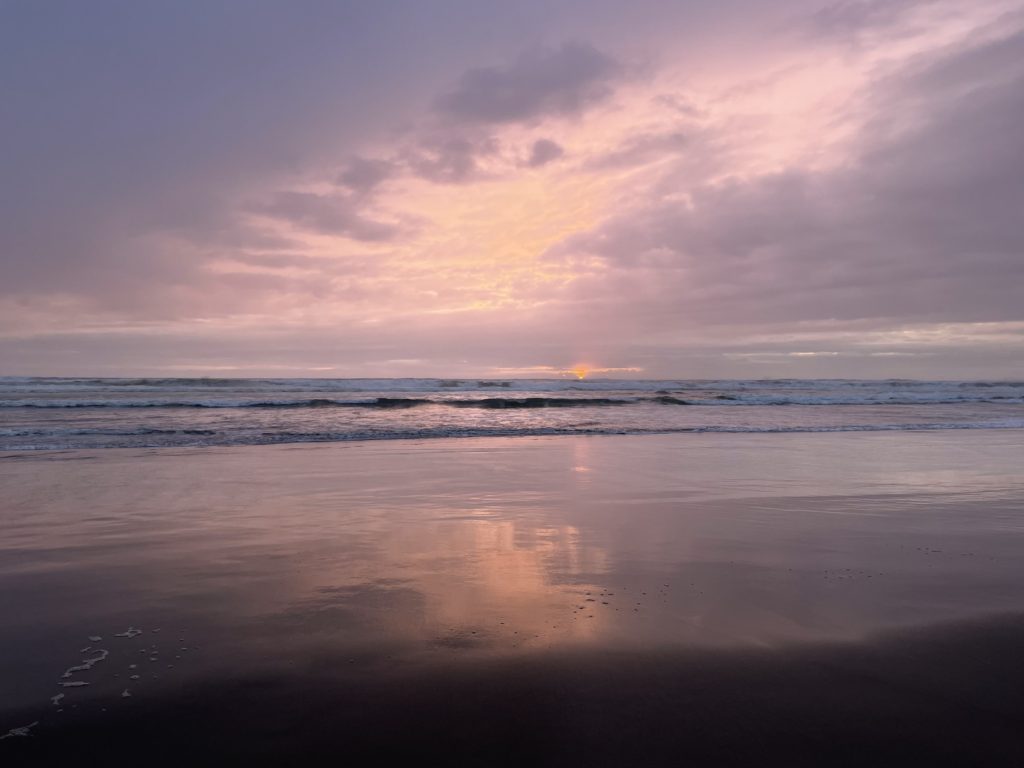
Dear friends,
I turned 64 a couple of weeks ago. Growing old has been on my mind a lot lately. It’s been damn stressful up in my brain. Here’s what’s helping me, offered to those of you who are also thinking about growing old and feeling stressed about it.
We were at the coast last week for our annual post-Easter rest. (My Episcopal priest husband naps. I walk.) As is often true of the Oregon coast in April, the weather was wet and windy. But every evening for a couple of hours, the rain would taper off and I’d drag Jed down to the beach to watch the sunset. On this particular evening, the sunset was subtle. A solid bank of clouds out over the ocean seemed set to block the sun’s rays as it sank into the sea. The cloudy sky turned a beautiful mauve and pink, mist gathered at the base of Mount Neahkahnie, and waves reflected the sky back to itself.
We passed a photographer with his tripod at the waves’ edge, long lens pointed to where the invisible sun might be. A family of five, their big black poodle bounding in the surf, walked up the beach toward Manzanita, occasionally glancing toward the western horizon. Jed and I were ready to go inside out of the wind ourselves, believing we’d seen all the show there was to see.
We were wrong. Suddenly the sun peeked out from a hole in the clouds and shone right at us. Immense. Orange. Stunningly beautiful—clouds above, below, and all around the one little hole. The sun had an entire limitless Pacific horizon to choose from, and she came down in the one place she could shine through. We were awestruck. Through binoculars we watched the curvature of the sun slowly sink behind the clouds like mountains. Words cannot describe.
I turned to see if the photographer was catching this, hopeful that he’d capture the shot of a lifetime. He was walking up the dunes, tripod over his shoulder, his back to the beauty blazing behind him. The family of five was likewise walking up the beach toward Manzanita, seemingly oblivious, black poodle still bounding in and out of the waves. We watched until the last burnished edge of sun sank below the cloud bank, and reminded each other to breath.
If we’d let the wind and the wet keep us inside, if we’d turned our backs too soon, if I hadn’t brought my binoculars … We would have missed it.
What does this moment have to do with growing old? Here’s my takeaway. If I expect my old age to be a long slide into mellowness and mist, if I turn my back too soon, I’ll miss many extraordinary moments. We see what we expect to see.
Show up. Get out on the beach, no matter what the weather.
Be present with each step and each breath. The future radiates out from the present like a wave.
The quality of your peaceful presence in this moment determines how your future will feel.
Your thoughts about aging—your thoughts about anything, really—will strongly impact your experience. You can choose different thoughts, if you want to and you do the work. (Learning to notice your thoughts and how to choose better ones is a core component of my coaching work.)
Expect the extraordinary.
Carry binoculars just in case.
Love,
Barb
PS. Some resources I’m finding helpful:
This episode of Glennon Doyle’s We Can Do Hard Things with anti-ageism activist Ashton Applewhite
This Chair Rocks: A Manifesto Against Ageism, by Ashton Applewhite
PPS. Interested in talking more about aging and how to think more helpful thoughts about this inevitable change? I offer free, no-strings-attached Clarity Calls.
PPPS. I share coaching availability and current events in my weekly email newsletter. Want to subscribe? Click here.
Photo: Manzanita Beach, Oregon. 2022.
In Praise of Emptiness
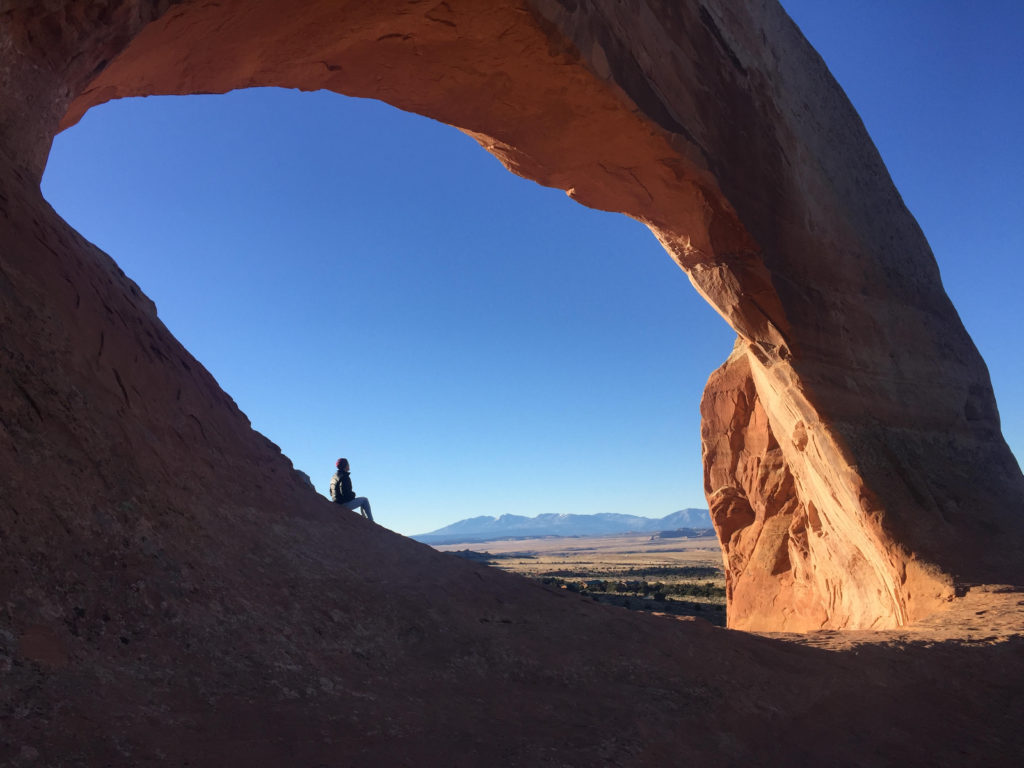
| Today is Holy Saturday in the western Christian tradition. Yesterday was Good Friday, the day of Crucifixion. Tomorrow is Easter Sunday, the day of Resurrection. Nothing much happens on Holy Saturday. There’s a lot of waiting and more than a little hopelessness in the gospel stories. This emptiness makes so much sense to me. To pause between death and resurrection is appropriate. To honor our emptiness is necessary. This pausing to honor emptiness can be uncomfortable, especially in our productivity-worshipping culture. Silence and space can be scary. We have the urge to rush to fill the pause. Sisters, stop and take a breath today. Grieve your endings. Fully inhabit your emptiness. Give yourself space and silence. Embrace this pause as a gift. As we lose the roles and identities accumulated during the first half of our lives, we begin to uncover who we really are, and who we want to become, in the second half. For women especially, the identities and roles of our first four to six decades are often defined by who we nurture—friends, siblings, spouses and partners, children, other people’s children, parents, institutions. When these roles are stripped away, we can come home to ourselves. Jesus of Nazareth preached trust in this process of losing and finding, over and over. “Those who want to save their life will lose it, and those who lose their life for my sake will find it.” These words are in every gospel, often in several places. I conclude that he really meant them. When we resist deaths, small and large, we stay stuck. When we cling to how life was, or how life should have been, or how we want life to be, we aren’t actually living at all. Because living happens right now, in this moment. When we accept the endings and hold ourselves gently in the space between death and hoped-for new life, resurrection happens. It’s inevitable. When we pause, when we wait, when we let what’s dead be dead, life will resurrect itself. Simply give it time. This holy pause pertains in other traditions, too. Christianity does not have a monopoly on death, resurrection, and the praise of emptiness. Christianity simply echoes and amplifies the cycle of death and rebirth encoded in our earthling DNA. Here’s the Tao Te Ching: We join spokes together in a wheel, but it is the centre hole that makes the wagon move. We shape clay into a pot, but it is the emptiness inside that holds whatever we want. We hammer wood for a house, but it is the inner space that makes it livable. We work with being, but non-being is what we use.* Remember who you are. Return to your body and your goodness. Reclaim your authority. Take your time. Honor your holy pauses. Honor the innate wisdom of change. Recommit to your priorities. Boundless compassion thrives within excellent boundaries. As much as you can, praise the emptiness of this moment. Honor this emptiness, this fallow field, as it is the ground of new life. Simply wait, and watch for green shoots to break through the bare earth. New life always breaks through. New life always breaks through, when you are ready. PS. To subscribe to my newsletter and receive my latest updates and posts, use this link. Thank you! Photo Credit: Wilson Arch, Utah, November 2016, Jed Holdorph *From Stephen Mitchell’s translation of the Tao Te Ching. |
How to use the holidays to grow your self-awareness.
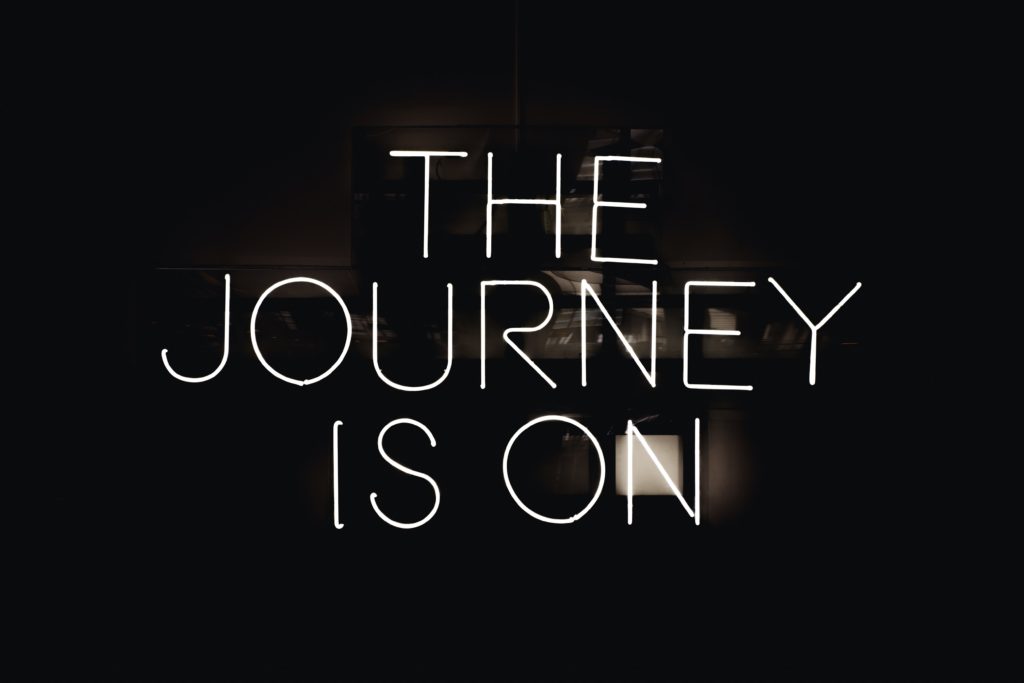
The Way Out is a book about healing chronic pain, written by Alan Gordon. Gordon says the process he teaches is best used when you’re in pain. (Highly recommend, BTW.) He wants you in pain, but not too much pain.
The same is true for working with your emotional pain and suffering. You want to be in your pain enough that it’s easy to notice and feel, but not so much that you’re incapacitated. So, the holiday season might be just the ticket for unraveling an emotional knot or two. Thanks, holidays!
If you want to use these day to gain a little more self-knowledge, do I have a tool for you! The Awareness Wheel, mentioned in last week’s newsletter, is the best tool I know for noticing thoughts that cause suffering.
A holiday gift: my first video on my brand new YouTube channel. Download your blank Awareness Wheel here, then come join me as we work through it together on this 15-minute video. Thank you in advance for your gracious hospitality as I figure out how to do this. (I didn’t realize how often I coach with my eyes closed!)
Wheel by wheel, you can begin to unravel the gnarly clusterf*cks (technical coachy jargon) that cause you to suffer. Awareness is the ground of healing. Awareness is crucial. Awareness doesn’t obligate you to change anything. You can practice awareness without ownership, but you can’t practice ownership without awareness.
Wheels help you go places faster and more efficiently. As always, I’m here for a free, no-strings-attached Clarity Call.
Happy holidays, dear readers. Thank you for being here. I am deeply grateful.
PS. We’ll focus on Awareness Wheels during our December Community Conversation. Join me on Saturday, December 18th at 9:00 am Pacific to work through one together. I’ll send the link in next Thursday’s newsletter and again the morning of. You can subscribe here.
PPS. As a perfectionist in recovery, it’s hard for me to post this video when I see so much I could have done better. This is spur of the moment, completely unedited. And, I’m doing it anyway! Maybe I’ll do a wheel on the need to be perfect. I hope you enjoy it, and that you find it useful.
Photo by Maxime Horlaville on Unsplash
Foundation #2: Awareness
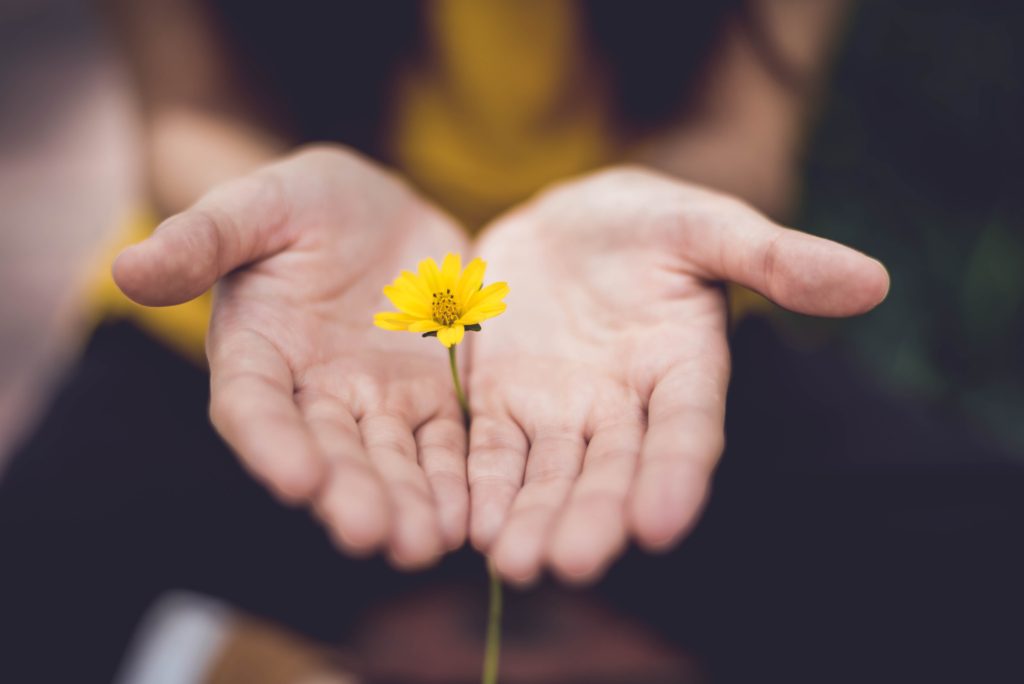
Foundation #2: Awareness. Bodyfulness + mindfulness = awareness. Awareness is attention. Attend to your life. Tend your soul.
Dwell as near as possible to the channel in which your life flows. ~Henry David Thoreau
(Three foundations – embodiment, awareness, and ownership – are fundamental. The four healing shifts – more soul, more acceptance, more intention, and more creation – are powerful. But the shifts without the foundations are like building a house on the sand. I’m diving deeper into these seven facets of healing throughout November and December. You can subscribe here if this was forwarded to you.)
Separating bodyfulness* from mindfulness is helpful, but it’s not truly accurate. We’re intertwined, of course – combined bodies and minds. It’s helpful to separate them, though, when we’re learning to notice our patterns and processes, and to tend ourselves.
Your body, your Earthling body, is your ground of being. We’re feeling creatures who think, says Dr. Jill Taylor Bolte in her new book, Whole Brain Living. Our minds work better when they’re in service to our bodies.
Now that you’re feeling your body a little more, let’s invite your powerful mind to the dance.
A Silly Story
Years ago, when I was a newby middle school English teacher, I was assigned to coach the school’s Brain Bowl team. I knew absolutely nothing about coaching Brain Bowl. Luckily for me, the Brain Bowl season didn’t start until March, so I could put off dealing with it for months while I learned to teach English. But I could feel my body tense every time my brain remembered Brain Bowl.
I began to picture Brain Bowl as a rattlesnake sleeping under my bed. You really don’t want rattlesnakes under your bed, right? If you’re not going to move out, you simply have to deal with them. Finally I did, by taking the obvious step of asking for help from the relieved senior teacher who’d shunted his unwanted duty onto me. The rattlesnakes under the bed began to slither on out.
That image has endured. I can still feel the frisson of fear running through my body when I imagine rattlesnakes sleeping under my bed. It’s my body’s way of telling me that something important I’d rather not think about needs my attention, and it’s time to deal with it.
Bodyfulness brings my attention to what needs healing. My mind works to understand and heal the sources of suffering.
Trauma
“The body keeps the score,” says trauma expert Dr. Bessel Van der Kolk. When you bring your attention to your body, when you choose to be mindful of your body, uncomfortable feelings will almost certainly arise. Our bodies are repositories of trauma. Humans sequester scary stuff in our bodies until we can deal with it, so you probably have unprocessed fear stored in your body. As you bring mindful, compassionate attention to your body, these emotions and stuck places will show up.
The good news is that bit by bit you can surface and resolve the trauma. First things first: If what shows up is overwhelming, back off for now and find a trauma-informed therapist to walk beside you. If stored trauma is making itself felt, it’s wanting to be healed. You can do this, and it’s easier and safer with company.
Adventures in Physical Therapy
As most of you know, I had surgery on my right hand a couple of months ago. I was sitting doing my seemingly interminable physical therapy Saturday morning while my husband read aloud Richard Rohr’s weekly email. In this email, Fr. Richard references Buddhist psychologist Tara Brach’s “applied meditation” RAIN, about which I have written before. R stands for “recognize,” A for “allow,” I for “investigate,” and N for “nurture.” It’s a powerful practice, and I’ve used it often.
As he was reading about RAIN and I was doing my PT, I recognized that I’ve been treating my hand, which is still quite stiff and swollen, as an enemy. I recognized that I’d been feeling ashamed of my hand’s wounded state. I detested the scars, stiffness, and swelling. That’s a strong word, and it’s also accurate.
(Feeling ashamed of illness, brokenness, and helplessness goes back to my childhood, but it doesn’t matter where it comes from. It’s not necessary to understand the genesis of a thought that causes suffering to begin to unravel its hold.)
My poor hand, to be treated so meanly. I was going through the motions of caring for it – massage, exercise, desensitization – while inwardly resenting the hell out of it.
RAIN helped me see that pattern. That old, deep, fossilized pattern became visible because I recognized the feeling of loathing in my body. Now I can heal the pattern, one PT session at a time.
This week I’ve been practicing breathe prayers while I do my physical therapy. I’ve been breathing in healing and breathing out stiffness. I’ve been breathing in healing and breathing out swelling. I’ve been doing my exercises to the beat of my heart. I’ve been loving on my hand and treating it with compassion. This feels better.
Pain, and Joy
So far I’ve been talking about the hard stuff that awareness helps us surface and deal with. But consciously practicing bodyfulness and mindfulness leads us not only to our pain, but also to our joy. The sources of our joy will likely be just as irrational as the sources of our pain, when we pay attention to our body’s joy. A warm shower. A walk in the woods. Playing around with words or paint. Purple twinkle lights around the bathroom mirror. Puppy videos on YouTube. Whatever.
A simple practice
Stop what you’re doing. Do a quick body scan from feet to head. What do you notice What sensations do you notice in your body? What emotions do you feel? Are you aware of any thoughts? Take a moment to note what you sensations, emotions, and thoughts on paper or in a notes app. Do this several times each day. Set an alarm on your phone if that would help.
Listen to what your body is telling you, then bring mindfulness to those messages. That’s all awareness is. Start small. Just notice. That’s all. You don’t need to be fancy and formal. Just keep track, somehow, of what you notice. Are there consistent body sensations? Consistent thoughts? Consistent patterns? Just notice.
Bring compassionate awareness to your daily embodied life. Little by little.
If you’d like to talk about any of this, simply “reply” to this email. I’d love to know what you think.
*I owe the wonderful word “bodyfulness” to Christine Valters Paintner, the abbess of Abbey of the Arts, a virtual contemplative and creative community. See especially The Wisdom of the Body.
Resources
Dr. Tara Brach on Fear and Trauma
Dr. Tara Brach and RAIN
Whole Brain Living, by Dr. Jill Bolte Taylor
The Body Keeps the Score, by Dr. Bessel Van der Kolk
The Wisdom of the Body, by Dr. Christine Valters Paintner
Photo credit: Lina Trochez on Unsplash
Seven good questions.
When you schedule a Clarity Call with me, I’ll ask you to answer three questions. Many of you tell me that those three questions alone provide you with powerful clarity before we ever begin working together.
1. What’s going on your life that’s causing pain or suffering?
2. What do you want to happen?
3. What obstacle(s) prevent your desired outcome?
Writing is thinking. Just writing down what’s going on, rather than letting it spin and spin in your mind, helps you see patterns and gives you insight into your own heart. Clearly articulating the issue helps us stop avoiding it and begin to give it our attention in a meaningful, healing way. We give ourselves regard and respect when we take the time to write down what’s hurting and where we’re struggling.
The second question comes from author Pam Grout, so long ago I can’t find the reference. These six words are powerful because the only way to have what you want is to know what you want. When you describe what you want in clear words, you’ve already begun to create it. You’ve begun to take your power back.
And question three gives you insight into what’s going on in your mind that’s keeping you stuck. I teach that thoughts create feelings, feelings lead to actions, and actions produce results. When you articulate your obstacles, you see them as either stuff you’ve made up in your mind that isn’t true, or as reality that must be accepted. Either way, you’ll know your next step.
These questions are why just 45 minutes together on a free, no-strings-attached Clarity Call can be life-changing. No kidding.
These next four questions, from psychotherapist and Holocaust survivor Dr. Edith Eger’s The Choice, are the focus of the last session in my three-month Coaching Intensive. They also underpin “Get Your Thing Done.”
1. What do you want?
2. Who wants it? (You, really, or someone else?)
3. What are you going to do about it?
4. When?
Coaching relationships begin and end with questions. Along the way, of course, there are many more questions. Good coaching is rich with good questions.
You might have noticed there’s not one “Why?” question among them. That’s because I find “Why?” questions generally unhelpful in coaching. “Why?” is more a therapist’s territory, which I am not. “Why?” can be a useful question to answer. “Why?” can also keep you stuck when you use it as an excuse not to take necessary action.
“What?” and “How?” are more my jam as a coach, which I most decidedly am. Throw in a little “When?” and we’re really rocking. “What?” and “How?” and the occasional “When?” will move you forward.
You don’t need me when you answer these questions, although saying something out loud (letting me or someone else “hear you into speech,” to paraphrase bell hooks) leads to greater awareness and greater accountability to our wild heart’s wisdom. There is power in using your voice to articulate your clarity.
Take some time to answer these questions. Answer them in the privacy of your journal, share them with a trusted friend, or talk them through with me. Revisit these questions regularly. Give yourself the gift of listening to yourself. Give yourself regard and respect. I think you’ll find yourself growing and healing as you see and hear yourself ever more clearly.
PS. Subscribe to my weekly letter for the latest news on coaching openings, new offerings, retreats, workshops, classes, and monthly Community Conversations. Thanks!
Photo credit: Billy Pasco on Unsplash.

